| Author |
Message |
|
Julian Reynolds
Location: United Kingdom Joined: 30 Mar 2008
Posts: 271
|
 Posted: Sun 04 Sep, 2011 12:09 pm Post subject: Boarding Axe Posted: Sun 04 Sep, 2011 12:09 pm Post subject: Boarding Axe |
 |
|
This weekend I made a little more progress on a project of mine - another 18thC boarding axe.
It started out as one of those camp, Conan-esque Hanwei Hero's Axe - the unlikely fantasy double-headed ones - which turned out to be very good steel with a lovely ring to it and really well tempered. A bit of severe grinder work (carefully done, so as not to heat it up too much) and it was cut to a more appropriate shape. I still need to finish the polishing to get it down to matt steel, but I'm almost there.
I made the spoon-ended langets from 16 gauge half-round mild steel stock. The 28" English ash haft is one of my stash of cricket stumps, suitably shaped and sanded.
I still need to inlet the langets into the haft, stain and oil the wood, then put it all together (and through rivet/peen the langets to the woodwork) once the head is polished.
I'll post pics when it's all done (can't say when that will be.....).
Enjoy, and be inspired,
Julian
 Attachment: 33.3 KB Attachment: 33.3 KB
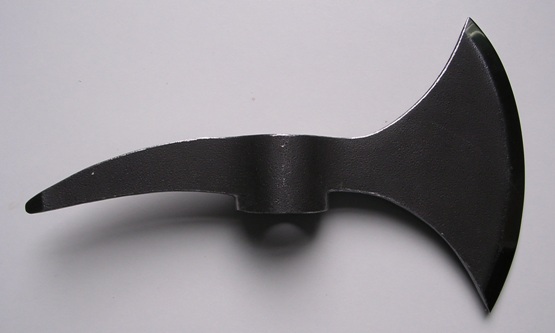
 Attachment: 51.64 KB Attachment: 51.64 KB

 Attachment: 42.96 KB Attachment: 42.96 KB
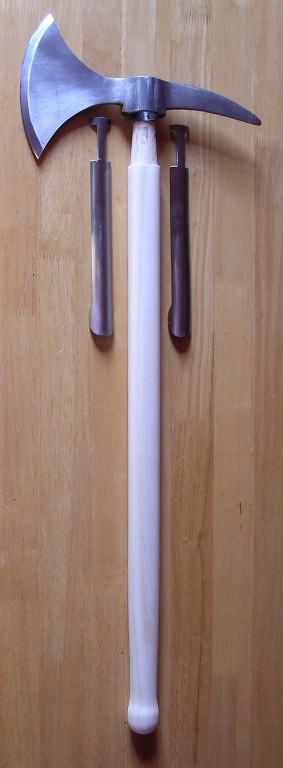
|
|
  |
 |
|
Julian Reynolds
Location: United Kingdom Joined: 30 Mar 2008
Posts: 271
|
 Posted: Sun 04 Sep, 2011 12:19 pm Post subject: Posted: Sun 04 Sep, 2011 12:19 pm Post subject: |
 |
|
Here's an example of a blunt version I made for re-enactment, along similar lines to the above, just to show where I am headed (eventually) with this project. The method of retaining the head via the langets (as well as the friction fit on the haft) makes it extremely secure and permanent. Should there ever be any looseness or rattle, over time, a simple steel wedge hammered in to the end would solve that issue.
 Attachment: 42.31 KB Attachment: 42.31 KB
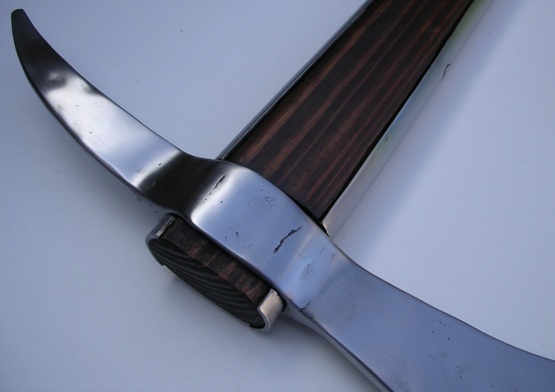
 Attachment: 24.57 KB Attachment: 24.57 KB
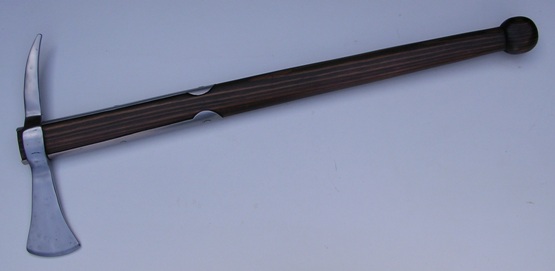
|
|
  |
 |
|
Julian Reynolds
Location: United Kingdom Joined: 30 Mar 2008
Posts: 271
|
 Posted: Sun 04 Sep, 2011 12:33 pm Post subject: Posted: Sun 04 Sep, 2011 12:33 pm Post subject: |
 |
|
And, to continue the theme, this morning I also completed a batch of 18thC grenados.
These were made using 2.5" diameter hollow steel balls (with a hole in) which I encouraged to get really, really rusty. Once cleaned up and stabilised, then blackened, the pitted surface closely resembles cast iron (instead of smooth steel).
A carved wooden bung fitted with a length of blackmatch completes the look.
Seen here alongside another boarding axe (made by Nick Johnson)........
Julian
 Attachment: 52.33 KB Attachment: 52.33 KB
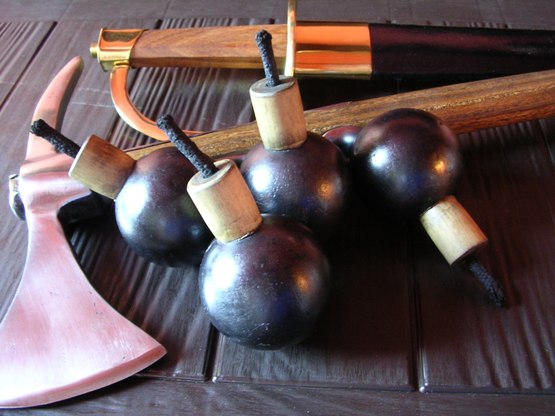
|
|
  |
 |
|
Jeffrey Faulk
|
 Posted: Sun 04 Sep, 2011 2:09 pm Post subject: Posted: Sun 04 Sep, 2011 2:09 pm Post subject: |
 |
|
Hello,
Your way of attaching the langets on the second one you made seems rather unusual. Weren't langets on the sides of the grip *opposite* to the blade and spike, rather than under them? Not a criticism, just want to see if this is a historical variation or your own concept.... it looks like you did great work there 
|
|
  |
 |
Ben Bouchard

Location: Bar Harbor, ME Joined: 17 Sep 2006
Posts: 47
|
 Posted: Sun 04 Sep, 2011 3:15 pm Post subject: Posted: Sun 04 Sep, 2011 3:15 pm Post subject: |
 |
|
|
In this case it's good for overstrike protection.
|
|
    |
 |
|
Julian Reynolds
Location: United Kingdom Joined: 30 Mar 2008
Posts: 271
|
 Posted: Sun 04 Sep, 2011 4:20 pm Post subject: Posted: Sun 04 Sep, 2011 4:20 pm Post subject: |
 |
|
Having langets front and back is historically correct. Below is a period example. Not only is it protection against overstrike, but for parrying purposes (against a bladed weapon) it protects the haft from a straight on 'true edge' strike. The 'wrap around' nature of the langets also prevent deep cuts into the haft from the sides. The best of both worlds, so to speak.
 Attachment: 55.96 KB Attachment: 55.96 KB
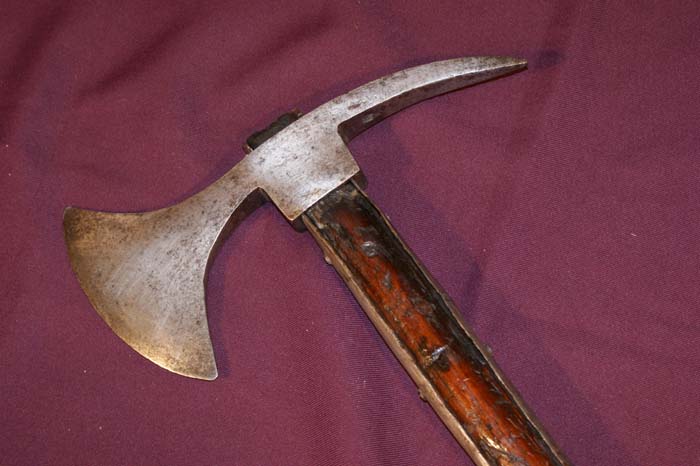
|
|
  |
 |
|
Julian Reynolds
Location: United Kingdom Joined: 30 Mar 2008
Posts: 271
|
 Posted: Sun 04 Sep, 2011 4:28 pm Post subject: Posted: Sun 04 Sep, 2011 4:28 pm Post subject: |
 |
|
And another period example from the 'Gentlemen of Fortune' website.
 Attachment: 10.22 KB Attachment: 10.22 KB
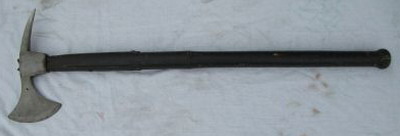
|
|
  |
 |
|
Gregg Sobocinski
|
 Posted: Sun 04 Sep, 2011 7:50 pm Post subject: Posted: Sun 04 Sep, 2011 7:50 pm Post subject: |
 |
|
It's interesting to see how that goes together. Nice work!
I appreciate seeing a good boarding axe. Since a ship has limited resources, I can see where making this tool/weapon extra durable would be a bonus. Thanks for sharing.
|
|
  |
 |
|
David Ledoyen
Industry Professional
|
 Posted: Sat 15 Oct, 2011 8:50 pm Post subject: Posted: Sat 15 Oct, 2011 8:50 pm Post subject: |
 |
|
| Jeffrey Faulk wrote: | Hello,
Your way of attaching the langets on the second one you made seems rather unusual. Weren't langets on the sides of the grip *opposite* to the blade and spike, rather than under them? Not a criticism, just want to see if this is a historical variation or your own concept.... it looks like you did great work there  |
Hello, on French axes, at least, the langets go under the blade and spike. You can see this on the 1833, 1786 and earlier pattern boarding axes. The langets has typical "mushroom" heads that prevent the axe's head to go off.
On the "side" of the handle this is the place of the belt hook if present.
David Ledoyen
www.theroyalsword.com
______________________
Man is nothing but dust. This gives some importance to the duster. — Alexandre Vialatte
|
|
   |
 |
Sa'ar Nudel

|
|
   |
 |
|
Julian Reynolds
Location: United Kingdom Joined: 30 Mar 2008
Posts: 271
|
 Posted: Sun 06 May, 2012 1:18 pm Post subject: Posted: Sun 06 May, 2012 1:18 pm Post subject: |
 |
|
I realised, looking through my previous topics, that I have commited the heinous crime of starting a DIY topic but not finishing it off........so here we go:
Below are some pics of the finished axe. I left a very light 'spattering' of the forged surface marks on the blade flats, to give it a more 'hand-forged' or even 'antique' look, but it was mostly taken down to a smooth semi-matt finish. The ash haft was stained and given a couple of coats of Danish oil then waxed.
This method of fixing the head is extremely solid and safe (you will never lose the head no matter how roughly you abuse it, because the langets lock it in place). It really is beautifully balanced, and as said before, the wickedly sharp blade has lovely 'ring' to it.
All told, it was around 4 good days in the workshop, but well worth it, in my opinion, especially when you consider its origins.
Julian
 Attachment: 37.7 KB Attachment: 37.7 KB

 Attachment: 38.53 KB Attachment: 38.53 KB
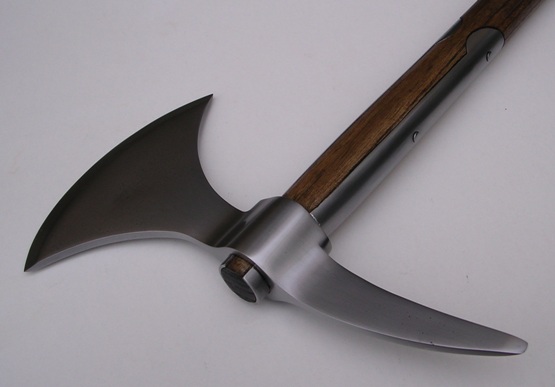
 Attachment: 59.78 KB Attachment: 59.78 KB
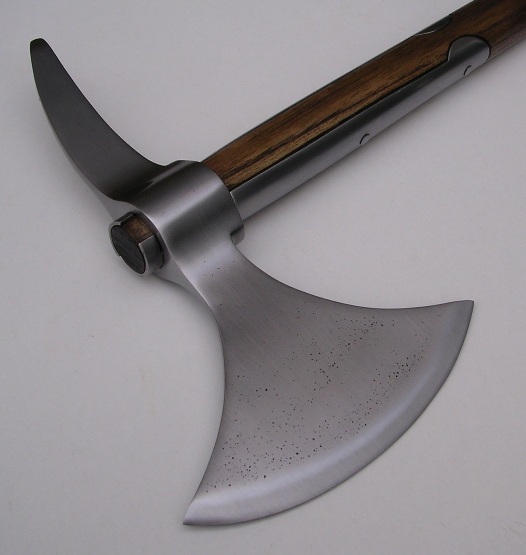
|
|
  |
 |
Sa'ar Nudel

|
 Posted: Mon 07 May, 2012 7:02 am Post subject: Posted: Mon 07 May, 2012 7:02 am Post subject: |
 |
|
Excellent job!
I would like to post in this thread my own 'privateer boarding axe'. It is the Spike Axe offered by Cold Steel, stripped off its black paint & etched, while the haft charred & stained.
 Attachment: 116.99 KB Attachment: 116.99 KB
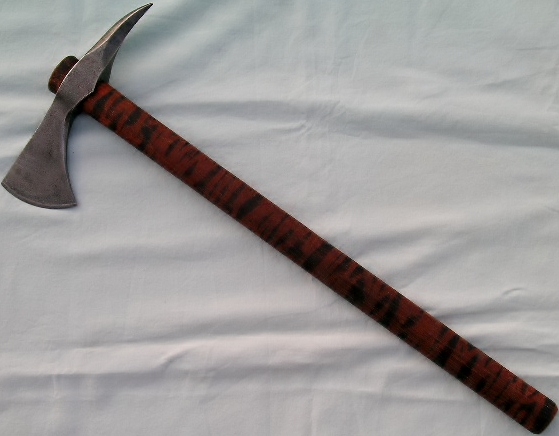
 Attachment: 85.26 KB Attachment: 85.26 KB
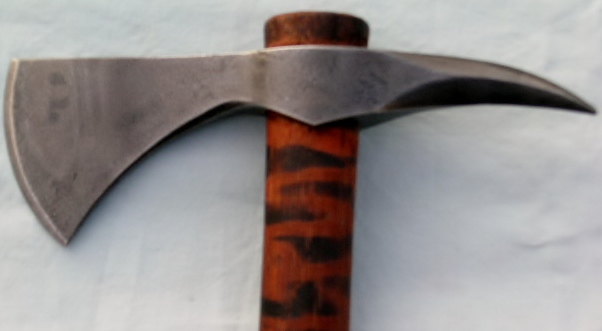
Curator of Beit Ussishkin, regional nature & history museum, Upper Galilee.
|
|
   |
 |
Corey Skriletz

Location: United States Joined: 27 May 2011
Posts: 118
|
 Posted: Wed 09 May, 2012 5:25 am Post subject: Posted: Wed 09 May, 2012 5:25 am Post subject: |
 |
|
| Julian Reynolds wrote: | And, to continue the theme, this morning I also completed a batch of 18thC grenados.
These were made using 2.5" diameter hollow steel balls (with a hole in) which I encouraged to get really, really rusty. Once cleaned up and stabilised, then blackened, the pitted surface closely resembles cast iron (instead of smooth steel).
A carved wooden bung fitted with a length of blackmatch completes the look.
Seen here alongside another boarding axe (made by Nick Johnson)........
Julian |
Julian: I know this is a bit late, but hopefully you'll see it. Where did you get the steel balls to make the grenados? They look great, by the way.
|
|
  |
 |
|
Julian Reynolds
Location: United Kingdom Joined: 30 Mar 2008
Posts: 271
|
 Posted: Wed 09 May, 2012 9:41 am Post subject: Posted: Wed 09 May, 2012 9:41 am Post subject: |
 |
|
Corey,
The steel balls I got from a guy here in the UK who specialises in blacksmithing supplies for reenactors, but also does a nice line in cannon balls, chain shot, bar shot etc. and goes by the unlikely name Dave the Iron Dwarf. Here's his tool site, but he can also be found on various UK living history/pirate forums:
http://www.medievalmade.co.uk/tools/
His finished products (including grenados) can be found on the Letters of Marque site:
http://www.lettersofmarque.co.uk/index.php?ma...dbe5daf026
although the originals would have had a rough-cast finish rather than the smooth steel of the LoM ones.
Don't know of any US source for this type of product.
Julian
|
|
  |
 |
|
|

